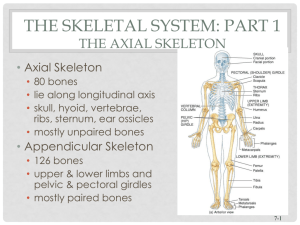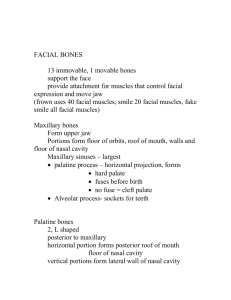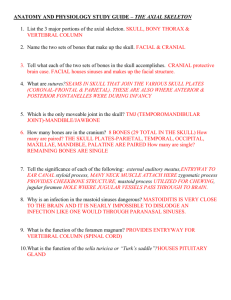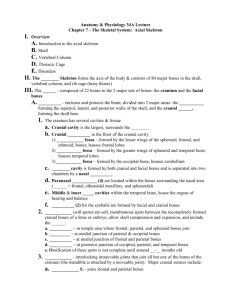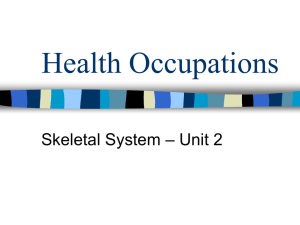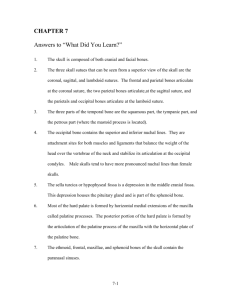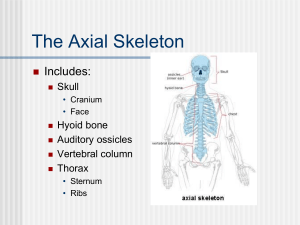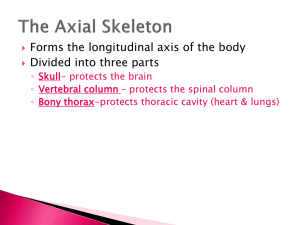Axial Skeleton - El Camino College
advertisement
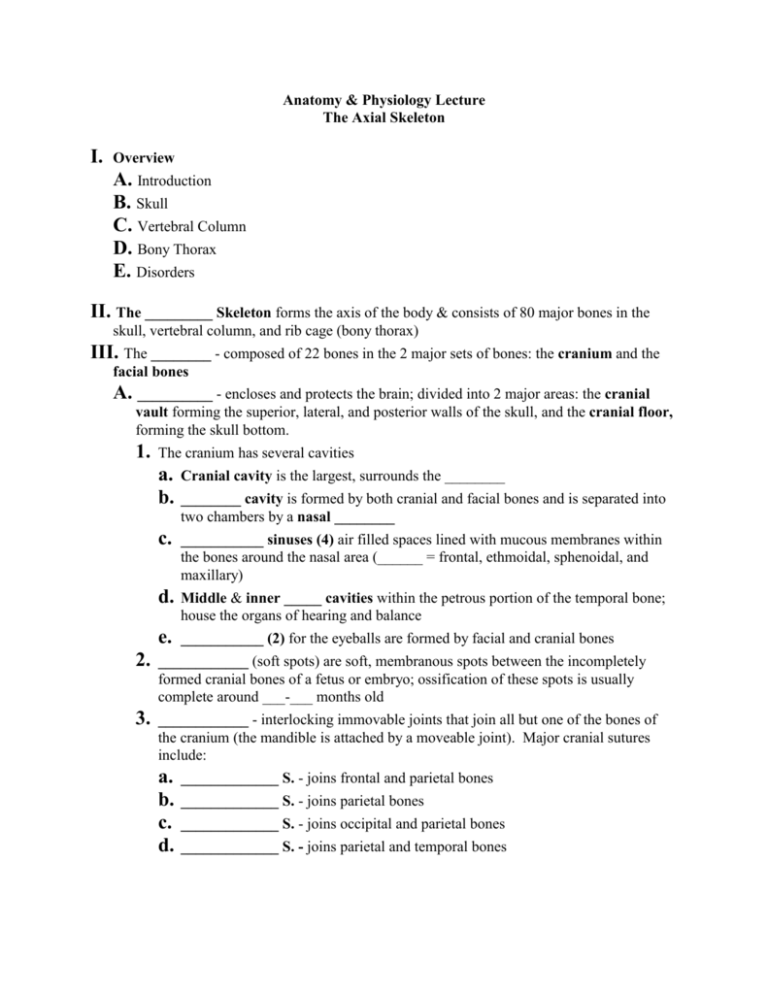
Anatomy & Physiology Lecture The Axial Skeleton I. Overview A. Introduction B. Skull C. Vertebral Column D. Bony Thorax E. Disorders II. The _________ Skeleton forms the axis of the body & consists of 80 major bones in the skull, vertebral column, and rib cage (bony thorax) III. The ________ - composed of 22 bones in the 2 major sets of bones: the cranium and the facial bones A. __________ - encloses and protects the brain; divided into 2 major areas: the cranial vault forming the superior, lateral, and posterior walls of the skull, and the cranial floor, forming the skull bottom. 1. The cranium has several cavities a. b. Cranial cavity is the largest, surrounds the ________ c. ___________ sinuses (4) air filled spaces lined with mucous membranes within the bones around the nasal area (______ = frontal, ethmoidal, sphenoidal, and maxillary) d. Middle & inner _____ cavities within the petrous portion of the temporal bone; house the organs of hearing and balance e. ___________ (2) for the eyeballs are formed by facial and cranial bones ________ cavity is formed by both cranial and facial bones and is separated into two chambers by a nasal ________ 2. ____________ (soft spots) are soft, membranous spots between the incompletely formed cranial bones of a fetus or embryo; ossification of these spots is usually complete around ___-___ months old 3. ____________ - interlocking immovable joints that join all but one of the bones of the cranium (the mandible is attached by a moveable joint). Major cranial sutures include: a. b. c. d. _____________ S. - joins frontal and parietal bones _____________ S. - joins parietal bones _____________ S. - joins occipital and parietal bones _____________ S. - joins parietal and temporal bones 2 4. Eight large, flat bones construct the _________ a. ____________ (forehead) bone - anterior cranium; includes roof of eye orbit and frontal sinuses b. ____________ bones (2) - superior, lateral bones of cranium; bordered by all 4 cranial sutures c. ____________ bones (2) - inferior to parietal bones; has external auditory meatus, mandibular fossa, styloid and mastoid processes d. ____________ bone - posterior, inferior bone of cranium; contains the foramen magnum and occipital condyles e. __________ bone - bat-shaped bone forming anterior plateau of middle cranial fossa; contains the _______________ (seat of the pituitary gland), and optic foramen (for optic nerve) f. _______________ bone - anterior to sphenoid 1) Forms upper nasal cavity, upper nasal __________ (perpendicular plate), superior & middle nasal conchae, and part of medial eye orbit 2) Contains the cribiform plate and ______ _______ B. ________ bones - 12 paired bones plus one mandible and vomer 1. ___________ - lower jaw; only movable bone of skull; has alveolar processes 2. ________ (2) - upper jaw; palatine process forms anterior hard palate; has alveolar processes between teeth 3. 4. 5. 6. 7. 8. ___________ (2) - posterior hard palate ____________ (2) - cheek bones; art. with temporal bone ____________ (2) - has lacrimal fossa, beneath tear ducts __________ (2) - bridge of nose ______ - inferior part of nasal septum in middle of nasal cavity Inferior Nasal _________ (turbinates) – curved lateral wall of nasal cavity; allows incoming air to be moistened and warmed C. ________ bone – U-shaped bone inferior to mandible; attachment site for tongue and other muscles IV. __________ (spinal) Column - extends from skull to pelvis; forms body’s major axial support; surrounds and protects spinal cord A. __________ vertebrae - __ neck vertebrae (C1-C7) 1. _______ - has lateral processes with facets that receive the occipital condyles of the skull; joint allows head to nod. 2. _______ - inferior to atlas; has a large process called a dens that allows the skull to pivot (indicating “no”). 3. Transverse processes contain __________ through which vertebral arteries pass to brain. 3 B. __________ Vertebrae - ___ vertebrae (T1-T12) posterior to rib cage; have facets for rib tubercles on transverse processes. C. __________ Vertebrae - 5 vertebrae (L1-L5) with large, block-like bodies and short, thick spinous processes extending directly backward. D. __________ - 5 fused vertebrae; articulates with L5 superiorly, with ilium laterally, and with coccyx inferiorly E. ___________ - 3-5 fused bones (tailbone). F. Typical _____________ have the following features: 1. ________ (centrum) - central rounded portion 2. Vertebral _____ - junction of all posterior projections 3. Vertebral __________ - large hole through which the spinal cord passes 4. ____________ processes - two lateral projections from the vertebral arch 5. __________ process - single medial, posterior projection from the vertebral arch 6. Superior & Inferior ___________ processes - paired projections lateral to the vertebral foramen that enable articulation with adjacent vertebrae 7. _______________ foramina - notches on the lateral superior & inferior surfaces of the vertebrae that allow spinal nerves to exit the spinal cord G. Vertebrae are separated by intervertebral ____ of ____cartilage that are composed of two regions: 1. ___________ pulposa - a central gelatinous area that behaves like a fluid and is surrounded by the 2. 3. ___________ fibrosus - an outer ring of collagenous fibers that stabilizes the disc In a ____________ disc, the nucleus pulposa herniates through the annulus and compresses adjacent nerves; very painful V. Bony Thorax (____ cage) - composed of sternum, ribs, and thoracic vertebrae; encloses and protects heart & lungs A. __________ (breast bone) - 3 fused flat bones 1. ___________ - looks like tie knot; articulates with clavicle (collarbone) and ribs 1 & 2 2. 3. _______ - forms majority of sternum; articulates directly or indirectly with ribs 2-10 ___________ process - inferior end of sternum; at level of 5th intercostal space; no ribs, but some abdominal muscles attach B. Ribs - ___ prs. of ribs form the thoracic cage: 1. ______ (vertebrosternal) ribs - 1st __ pr. ribs, all increasing in length; attach directly to sternum via their costal cartilage 2. _______ (vertebrochondral) ribs - next __ pr. Ribs; attach indirectly via hyaline cartilage to sternum 4 3. 4. 5. _________ (vertebral) ribs – __ pr. of false ribs with no sternal attachment _____________ spaces are found between the ribs A typical ____ (#3-9) has the following features: a. b. c. _______ & tubercle articulate with the vertebra _______ - distal to the head _______ (shaft) - long, straight part of the rib VI. _____________ of the Axial Skeleton A. Abnormal __________ curvatures include: 1. ____________ - lateral curvature of more than 10, usually in the thoracic region; may result from legs of unequal length 2. ____________ (hunchback) - dorasal curvature of the thoracic region; most common in older women due to osteoporosis 3. ____________ (swayback) - accentuated lumbar curvature; may result from osteomalacia B. __________ __________ - incomplete formation of the vertebral arches surrounding the spinal cord; may result in paralysis; can be prevented by taking folic acid during pregnancy C. _____________ - congenital abnormality in which the right & left palate bones fail to join medially; may also be prevented by taking folic acid during pregnancy
